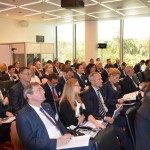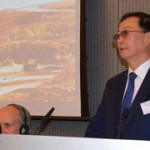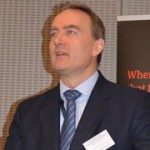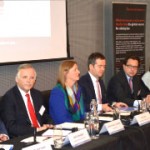
Due to weak commodity prices in the past five years Russia, Kazakhstan, Mongolia and other Central Asian countries whose economies are built around extractive industries have been going through hard economic times. Although Foreign Direct Investment (FDI) is considered the key instrument for stimulating economic growth, the relationships between the Governments and Foreign Investors in these countries were far from ideal. Have the parties been able to learn from their costly mistakes and will the recovery of commodity markets translate into FDI boom in the mining sector and economic reinvigoration in 2017 and beyond?
MINEX Eurasia Conference organised in London on 28 November provided an insight into the changes, which will be shaping up investment climate in the mining industries of Russia, Kazakhstan and Mongolia.
Key legislation changes in Mongolia, Russia, Kazakhstan and were presented by Badamsuren Khookhor, Vice-Minister, Ministry of Mining and Heavy Industry of Mongolia, Angelica Phillips, Co-Chair, UK-Kazakhstan Inter-Governmental Commission and Simon Cox, Partner, Norton Rose Fulbright LLP.
Macro and Investment overview on Russia, Kazakhstan, Mongolia and Uzbekistan was presented by Chris Weafer, Senior Partner, Macro-Advisory Ltd. According to Mr. Weafer, the Eurasian countries are being forced onto a new path because of political changes and as old economic models are no longer viable.
Russia’s old economic model has matured. A new investment based model is now required to replace the decreasing share of oil, which represents less than 35% of budget revenues. Russia is today a low cost economy. A cheap rouble is at the core of efforts to create a competitive economic base. Although the Russian Economy has enough resources to “muddle-through”, the return to targeted growth of 3.5-4.5% will require a pick-up in investment.\
Kazakhstan’s economy has suffered because of an over reliance on hydrocarbon revenues and contagion from the Russian recession. Devaluation of Tenge was badly handled and has created legacy problems in the banking sector. Budget deficit has expanded as government tries to maintain social stability. The Government has announced very ambitious reform and industrial programmes, however, investors are awaiting specifics before committing. There are often mixed messages concerning investment into natural resources. Government policy is to attract inward investment but local management in strategic companies are often obstructive. Being the key player in the Eurasian Economic Union and strategic member in China’s “Silk route” project, Kazakhstan is expected to conclude substantial investment deals with Iran, India and Turkey.
 Political and regime change in Mongolia, along with shifting expectations of the population, should help create a more favourable FDI climate. June election produced surprise result with the Mongolian People’s Party (MPP) taking 85% of the seats in parliament. The MPP was previously opposed to foreign investment and especially to foreign control. Economic realities have changed that stance. The new government is promising a more open and investment friendly climate. The immediate priority is to restructure the budget, create new jobs and get new funding to cover external obligations falling due. There are also contradictions to be resolved, such as how to extract more from mining projects while boosting FDI. FDI recovery is the key to economic growth and to both social and political stability. Tavan Tolgoi is considered to be a test case to watch.
Political and regime change in Mongolia, along with shifting expectations of the population, should help create a more favourable FDI climate. June election produced surprise result with the Mongolian People’s Party (MPP) taking 85% of the seats in parliament. The MPP was previously opposed to foreign investment and especially to foreign control. Economic realities have changed that stance. The new government is promising a more open and investment friendly climate. The immediate priority is to restructure the budget, create new jobs and get new funding to cover external obligations falling due. There are also contradictions to be resolved, such as how to extract more from mining projects while boosting FDI. FDI recovery is the key to economic growth and to both social and political stability. Tavan Tolgoi is considered to be a test case to watch.
Uzbekistan’s 32 million people economy has been almost closed to outside investors for 25 years. The country’s vast resources are under-developed. The political regime change (election on 4th December) may bring big changes and opportunities for investors in Gold and Uranium sectors.
According to the UNCTAD review of investment policy in Kyrgyzstan and Tajikistan submitted by investment policy expert Mr. Massimo Meloni, these counties attract relatively less FDI compared to Uzbekistan. Inflows are concentrated in few large mining-related projects. Proximity to China, vast resources and political reforms to improve investment climate in Kyrgyzstan and Tajikistan create positive foundations for FDI growth in the next few years.
What triggers investment and what checks and balances are important today to foreign investors in the mining sector in Eurasia? A thought provoking presentation by Eric Rasmussen, Director Natural Resources, European Bank for Reconstruction and Development offered a simplified view of the investor’s mind-set. EBRD itself is a key investor in the extractive industries sector with 175 projects for a total of EUR 7.65 billion investment in its current portfolio.
 EBRD’s Natural Resources team believes that a considerable uncertainty in commodity markets will remain and general outlook for extractive industries will be subdued. Miners are challenged by oversupply of several commodities and growing pressure from governments and stakeholders. The key investment drivers in the mining sector are the tier 1 assets that produce substantial quantities at below industry costs, commodity demand from China and other countries, mining costs (local tax, environmental regulation and export limitations), focus on developing smaller brownfield instead of greenfield projects. The list of major mining risks include productivity improvements and cost efficiency, restricted access to capital to support growth and greenfield exploration, Social Licence to Operate.
EBRD’s Natural Resources team believes that a considerable uncertainty in commodity markets will remain and general outlook for extractive industries will be subdued. Miners are challenged by oversupply of several commodities and growing pressure from governments and stakeholders. The key investment drivers in the mining sector are the tier 1 assets that produce substantial quantities at below industry costs, commodity demand from China and other countries, mining costs (local tax, environmental regulation and export limitations), focus on developing smaller brownfield instead of greenfield projects. The list of major mining risks include productivity improvements and cost efficiency, restricted access to capital to support growth and greenfield exploration, Social Licence to Operate.
Talking about the prospects of funding mining projects in the Eurasian region many experts agreed that the bottom has been reached and some of the sub-sectors are already showing some positive indicators. Alex Metherell, Co-Head of Global Banking at VTB Capital reflected on the Bank’s transactions in the last six months. Most of the projects were able to secure debt finance and raise equity capital. PGM and diamond projects enjoyed particular interest. New investment is expected in the coal sector. Iron ore and steel producers still face challenges. The overall pipeline for the next 12 months is more productive compared to the last two years. The view that appetite for equity funding in the market sector will increase in 2017 was shared by Ayuna Nechaeva, Head of Russia, CIS & Mongolia Primary Markets, London Stock Exchange and Peter Whelan, Partner, Equity Advisory at PwC.
Vomic Nur Shah, the Head of Europe, CIS, Middle East, Asia of the UK Export Finance noted that following the recent Chancellor’s statement, the Agency is planning to double its level of commitment to financing mining projects in Central Asia. The essential part of the financial package offered to projects is that the UK content (equipment and / or services) should be no less than 20%.
 Ingo Hofmaier, Head of Mining at Hannam & Partners (Advisory) LLP expects that funding of exploration projects will be facing considerable challenges as major banks have moved from this sector. Success in securing financing depends on the quality of projects and local partnerships who could provide the right mix of equity, cash and technological support. Talking about the London Capital market liquidity, Mr. Hofmaier illustrated a research conducted by Hannam & Partners over the past two years. Most of the share prices of diversified and commodity companies were moving in tandem. They hit the bottom between October 2015 and January 2016. Since then the prices were recovering. Some of the copper mining companies who have been able to secure long term financing from the institutional investors or the Chinese banks saw their shares soaring by as much as 300% by the end of this year.
Ingo Hofmaier, Head of Mining at Hannam & Partners (Advisory) LLP expects that funding of exploration projects will be facing considerable challenges as major banks have moved from this sector. Success in securing financing depends on the quality of projects and local partnerships who could provide the right mix of equity, cash and technological support. Talking about the London Capital market liquidity, Mr. Hofmaier illustrated a research conducted by Hannam & Partners over the past two years. Most of the share prices of diversified and commodity companies were moving in tandem. They hit the bottom between October 2015 and January 2016. Since then the prices were recovering. Some of the copper mining companies who have been able to secure long term financing from the institutional investors or the Chinese banks saw their shares soaring by as much as 300% by the end of this year.
Mining investment cases and projects presented at the Conference
Russia
Mangazeisky Silver Project, Russia – Path to Production
Robin Birchall -Director, Silver Bear Resources Inc. www.silverbearresources.com
The Unkur Project: A High Grade Silver Copper Deposit in the Zabaikalsky Region
Dorian L. (Dusty) Nicol – President and CEO, Azarga Metals Corp. – www.azargametals.com
Developing projects from Prospecting into Production in Lena Goldfields
Mr. Mikhail Damrin – CEO, Kopy Goldfields AB – www.kopygoldfields.com
Kazakhstan
Introduction to Central Asia Metals.
Nick Clarke – Executive Chairman, Central Asia Metals – www.centralasiametals.com
Exore Ltd project portfolio.
Robert Machowski – Technical Director, Exore Ltd – www.exoremining.co.uk
Metallogenic analysis to unlock Central Eurasia’s hidden mineral resource potential
Dr. Reimar Seltmann – Head, CERCAMS and Research Leader, Natural History Museum and
Antony Benham – Chief Operations Officer, IGS (International Geoscience Services) Ltd
Mongolia
Oyu Tolgoi – the story of Mongolia’s largest mining development.
Ulf Quellmann, Chief Financial Officer, Copper and Diamonds, Rio Tinto plc – www.riotinto.com
Erdenes Mongol’s ongoing commitment to “Strategic Transformation”.
Tumentsogt Tsevegmid, CEO, Erdenes Mongol – www.erdenesmongol.mn
Developing a New Gold District in Southwest Mongolia.
Peter C. Akerley, President and Director, Erdene Resource Development – www.erdene.com
Leading regional exploration play in an emerging world class, gold rich copper belt.
Jonathan Spring, Director, President and CEO, Kincora Copper Limited – www.kincoracopper.com
Unlocking Mongolia’s Copper-Gold Belts.
Dr Andrew Stewart, Managing Director & CEO, Xanadu Mines Ltd – www.xanadumines.com
For a free copy of the full conference report please visit: https://2016.minexeurasia.com/
or contact MINEX Forum secretariat by admin@minexforum.com or Phone: +44 207 520 9341






